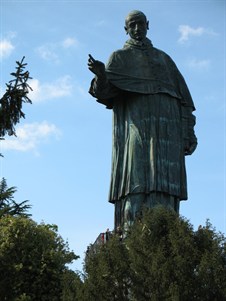The Borromeo
 The Borromeo family is one of the most important families in the history of Milan, powerful both politically and economically, and are still owners of vast tracts of real estate in the North of Italy. The earliest records of the family date back to the end of the thirteenth century, when the “Buon Romei”, originally from Rome, experienced rapid economic fortune (above all thanks to banking), also bound themselves to the powerful Visconti family. They moved to Milan and Padua in the second half of the fourteenth century, and it was in Padua that Vitaliano I was born from the marriage between Giacomo Vitaliani and Margherita Borromeo, who was adopted by his maternal uncle Giovanni Borromeo provided he take the surname, thus making him the founder of the great dynasty from Milan. Among the members of the clan, there are two prominent names in the religious history of Italy in the sixteenth and seventeenth century, and in particular of Milan: cardinal Charles Borromeo (1538-1584), Archbishop of Milan from 1564 until his death and later canonized by Paul V in 1610, and Federico Borromeo (1564-1631), who was also archbishop of Milan from 1595 until his death. Carlo III Borromeo, however, married Isabella d’Adda and started work on the transformation of Isola Bella on Lake Maggiore. Among the various properties of the different branches of the family, we recall, in addition to Isola Bella, the Borromeo d’Adda palaces in Via Manzoni in Milan, Arese Borromeo in Cesano Maderno and Gabrielli-Borromeo in Rome; Villa Visconti Borromeo Arese Litta in Lainate; the castles of Camairago, Cassano d’ Adda, Corneliano Bertario, Origgio, Peschiera Borromeo and Rocca d’Angera.
The Borromeo family is one of the most important families in the history of Milan, powerful both politically and economically, and are still owners of vast tracts of real estate in the North of Italy. The earliest records of the family date back to the end of the thirteenth century, when the “Buon Romei”, originally from Rome, experienced rapid economic fortune (above all thanks to banking), also bound themselves to the powerful Visconti family. They moved to Milan and Padua in the second half of the fourteenth century, and it was in Padua that Vitaliano I was born from the marriage between Giacomo Vitaliani and Margherita Borromeo, who was adopted by his maternal uncle Giovanni Borromeo provided he take the surname, thus making him the founder of the great dynasty from Milan. Among the members of the clan, there are two prominent names in the religious history of Italy in the sixteenth and seventeenth century, and in particular of Milan: cardinal Charles Borromeo (1538-1584), Archbishop of Milan from 1564 until his death and later canonized by Paul V in 1610, and Federico Borromeo (1564-1631), who was also archbishop of Milan from 1595 until his death. Carlo III Borromeo, however, married Isabella d’Adda and started work on the transformation of Isola Bella on Lake Maggiore. Among the various properties of the different branches of the family, we recall, in addition to Isola Bella, the Borromeo d’Adda palaces in Via Manzoni in Milan, Arese Borromeo in Cesano Maderno and Gabrielli-Borromeo in Rome; Villa Visconti Borromeo Arese Litta in Lainate; the castles of Camairago, Cassano d’ Adda, Corneliano Bertario, Origgio, Peschiera Borromeo and Rocca d’Angera.
Read more :
-
H. Jedin, Carlo Borromeo, Roma 1971.
-
W. de Boer, The conquest of the soul. Confession, discipline, and public order in counter reformation Milan, Leiden 2001.
